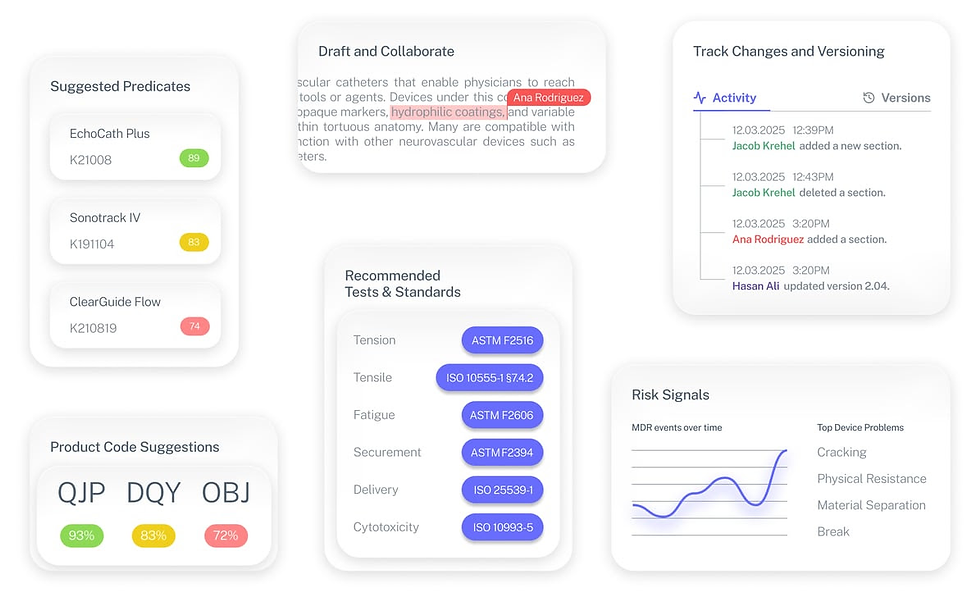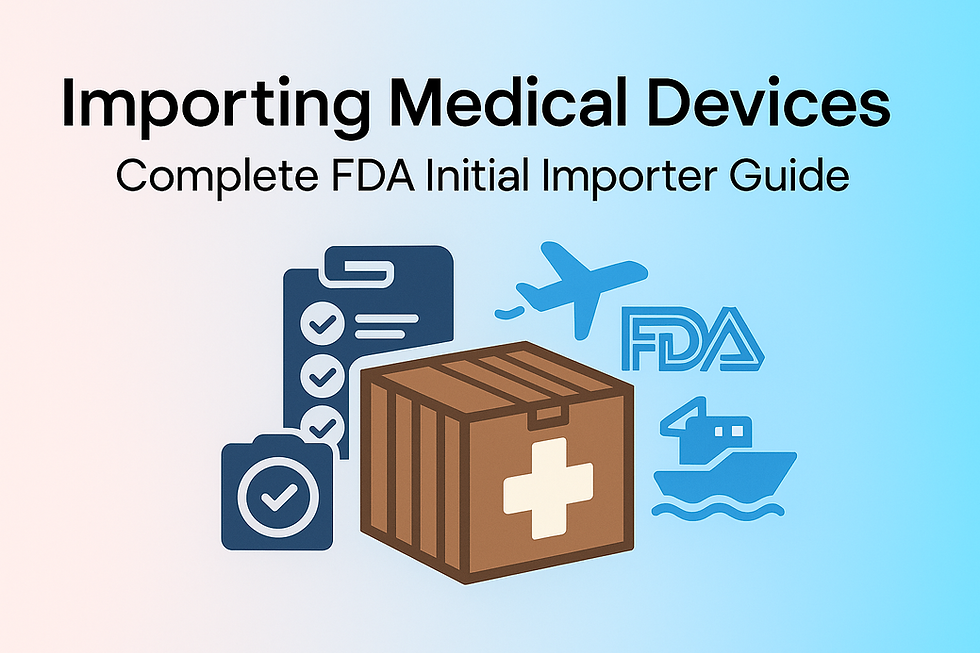Safe Medical Devices Act (SMDA): What It Means in 2025 — MDR, User-Facility Rule & Penalties
- Beng Ee Lim

- Jul 29
- 8 min read
Updated: Sep 7
The Safe Medical Devices Act of 1990 amended the FD&C Act and reshaped US postmarket controls. It created mandatory user-facility MDR reporting, authorized Section 522 postmarket surveillance, required device tracking, and added reports of corrections and removals. SMDA also established the Humanitarian Device Exemption (HDE) pathway. Today these duties are implemented in 21 CFR 803, 806, 821, and 822.
Non-compliance triggers civil penalties up to $15,000 per violation plus criminal liability. Smart companies leverage SMDA data for competitive intelligence, risk management, and market positioning while building reporting systems that prevent regulatory crises.
This guide breaks it all down.

The $5 Million Mistake Most Companies Make
Case Study: MedTech Startup X ignored adverse event reports for 6 months, assuming they were "isolated incidents." FDA discovered the pattern during a routine inspection. Result: $2.3 million in civil penalties, 18-month market withdrawal, and $15 million recall. Company never recovered.
The Reality: More than 1.7 million injuries and nearly 83,000 deaths can be linked to medical devices over a recent 10-year period, yet most companies still treat SMDA reporting as an administrative burden rather than a business-critical early warning system.
What This Costs You Today
Immediate Financial Impact:
Civil penalties: Up to $15,000 per violation (can be millions for systematic failures)
Criminal liability: Individual executives face personal prosecution for willful violations
Market withdrawal costs: $5-50 million for device recalls and corrective actions
Competitive damage: Public MAUDE data reveals your safety issues to competitors
Hidden Strategic Costs:
Lost market intelligence: Missing competitor safety trends that create opportunities
Delayed crisis response: Late adverse event detection turns minor issues into major recalls
Regulatory relationship damage: FDA treats poor SMDA compliance as indicator of overall quality problems
Investment impact: VCs and acquirers scrutinize MAUDE data during due diligence
The Smart Company Advantage: Companies with robust SMDA compliance get faster FDA approvals, avoid costly surprises, and use competitor adverse event data to gain market share.
What SMDA Actually Requires (Beyond the Basics)
Most companies know SMDA requires "adverse event reporting" but miss the strategic requirements that separate winners from losers.
Manufacturer Reporting Requirements
Death Reports: Must report deaths within 30 calendar days of becoming aware of the event to both FDA and affected parties
Serious Injury Reports: 30-day reporting requirement for injuries requiring medical intervention
Malfunction Reports: 30-day reporting for device failures that could cause death or serious injury if they recurred
The Strategic Miss: Most companies focus on timeframes but ignore the "could cause" standard for malfunctions. This creates massive liability exposure for unreported issues.
User Facility Requirements
Hospitals and Healthcare Facilities Must:
Report deaths to both the FDA and the manufacturer within 10 working days
Report serious injuries to manufacturer within 10 working days
Submit annual summary reports to FDA by January 1
The Intelligence Opportunity: User facility reports in MAUDE reveal real-world device performance that manufacturers might not know about their own products.
The Tracking and Surveillance Trap
Post-Market Surveillance: FDA gained authority for post-market surveillance for monitoring of products after their clearance to market and device tracking for maintaining traceability of certain devices to the user level
What This Means: FDA can order expensive post-market studies for any device showing concerning SMDA patterns. Prevention through robust reporting prevents these costly mandates.
The Hidden Business Intelligence Goldmine
Smart companies don't just comply with SMDA—they weaponize it for competitive advantage.
Competitive Intelligence from MAUDE Data
Track Competitor Failures:
Every adverse event report becomes public data in FDA's MAUDE database
Identify competitor product weaknesses before they're publicly disclosed
Spot market opportunities when competitor devices show safety patterns
Time product launches around competitor recalls and safety issues
Real Example: Company Y monitored MAUDE reports for Competitor Z's implantable device. Noticed increasing infection reports 6 months before public recall. Company Y accelerated their competing product launch and captured 40% market share during competitor's recall period.
Early Warning System for Your Products
Pattern Recognition:
SMDA reports reveal safety trends before they become crises
Geographic clusters that indicate training or procedural issues
User error patterns that suggest labeling or design problems
Component failure trends that predict broader quality issues
Financial Impact: Proactive fixes (lab tests, label updates) rarely top $500 K, while full recalls average $3.5 M and can rocket past $600 M for system-wide failures.
Risk Management Integration
Insurance and Legal Strategy:
SMDA compliance affects product liability exposure
Good reporting demonstrates corporate responsibility during litigation
Early adverse event response reduces damages in lawsuits
Insurance companies consider SMDA compliance in premium calculations
Building a Strategic SMDA Compliance System
Most companies build SMDA systems for minimum compliance. Strategic companies build systems for maximum business advantage.
The Reporting Infrastructure That Wins
Immediate Response Protocols:
24-hour death reporting system (not 30-day minimum)
Real-time adverse event triage by clinical severity
Automatic legal and regulatory team notification
Customer communication templates for serious events
Data Integration Strategy:
Link SMDA reports to quality management systems
Connect adverse events to design control processes
Integrate customer complaints with SMDA reporting
Feed SMDA patterns into R&D risk assessments
The Competitive Intelligence Framework
MAUDE Monitoring System:
Automated competitor adverse event tracking
Market opportunity alerts based on competitor patterns
Safety benchmarking against industry averages
Geographic and user facility analysis for market insights
Strategic Applications:
Product Development: Use competitor failure modes to improve your designs
Marketing: Highlight your safety profile when competitors show MAUDE problems
Business Development: Time partnership discussions around competitor weaknesses
Investment: Due diligence on acquisition targets using MAUDE data
The Compliance Mistakes That Kill Companies
Learn from others' failures to avoid repeating million-dollar mistakes.
The "No Pattern" Fallacy
Mistake: Treating each adverse event as isolated incident without pattern analysis
Reality: FDA looks for trends across time, geography, and user types
Cost: Missing emerging patterns leads to late recalls and massive liability
Example: Exactech’s missed oxidation pattern forced one of the largest ortho recalls on record (650 k implants) and bankruptcy protection. Lesson: run quarterly MAUDE heat-maps (signal, geography, user-type) or risk a nine-figure catastrophe.
The Delayed Reporting Death Spiral
Mistake: Waiting for "complete information" before reporting to FDA
Reality: 30-day reporting clock starts when you become aware of potential adverse event, not when investigation concludes
Cost: Late reporting triggers civil penalties even if device isn't at fault
The "User Error" Defense Disaster
Mistake: Dismissing adverse events as "user error" without proper investigation
Reality: Pattern of user errors indicates design deficiencies requiring corrective action
Cost: FDA treats repeated "user error" claims as evidence of poor device design
Advanced SMDA Strategies for Market Leaders
Transform SMDA from compliance burden into competitive weapon through strategic application.
The Pre-Market Intelligence Advantage
Before Product Launch:
Analyze MAUDE data for predicate devices to identify improvement opportunities
Study competitor adverse event patterns to differentiate your design
Use SMDA patterns to inform clinical trial endpoints and safety monitoring
Build post-market surveillance plans based on competitive intelligence
Post-Market Domination Strategy
After Product Launch:
Monitor your MAUDE profile vs. competitors for marketing advantages
Use clean MAUDE record in sales presentations and competitive positioning
Leverage adverse event data for product improvement and next-generation development
Build customer confidence through transparent safety communication
The Regulatory Relationship Multiplier
FDA Perspective: Companies with excellent SMDA compliance get benefit of doubt on borderline regulatory decisions
Strategic Value: Good SMDA track record accelerates approvals for new products and indications
Long-term Impact: Regulatory trust built through SMDA compliance pays dividends across entire product portfolio
Implementation Roadmap: From Compliance to Competitive Advantage
Phase 1: Foundation (Months 1-3)
Audit current SMDA compliance gaps and legal exposure
Implement 24-hour reporting infrastructure for deaths
Train all customer-facing teams on adverse event recognition
Establish legal review processes for all SMDA reports
Phase 2: Intelligence (Months 3-6)
Build automated MAUDE monitoring for competitors
Integrate SMDA data with quality management systems
Develop adverse event trend analysis capabilities
Create cross-functional response teams for serious events
Phase 3: Strategic Advantage (Months 6-12)
Use MAUDE intelligence for product development decisions
Incorporate safety profile into marketing and sales strategies
Leverage SMDA compliance for regulatory relationship building
Build predictive analytics for adverse event prevention
Turn SMDA from Liability into Competitive Advantage
The Safe Medical Devices Act isn't going away. In 2025, it's more relevant than ever as FDA increases enforcement and uses adverse event data for real-world evidence initiatives.
The Choice Is Clear:
Option A: Treat SMDA as paperwork compliance and risk million-dollar penalties, recalls, and competitive disadvantage
Option B: Build strategic SMDA systems that prevent crises, generate competitive intelligence, and position your company as the safe choice in the market
Success Metrics for Strategic SMDA Implementation:
Zero late reports (demonstrates system reliability)
Proactive adverse event communication (builds customer trust)
Competitive safety advantages identified through MAUDE analysis
Faster FDA reviews due to excellent compliance reputation
SMDA compliance done right isn't just about avoiding penalties—it's about building sustainable competitive advantages through superior safety intelligence and regulatory excellence.
The Fastest Path to Market
No more guesswork. Move from research to a defendable FDA strategy, faster. Backed by FDA sources. Teams report 12 hours saved weekly.
FDA Product Code Finder, find your code in minutes.
510(k) Predicate Intelligence, see likely predicates with 510(k) links.
Risk and Recalls, scan MAUDE and recall patterns.
FDA Tests and Standards, map required tests from your code.
Regulatory Strategy Workspace, pull it into a defendable plan.
👉 Start free at complizen.ai

Frequently Asked Questions
What happens if we miss the 30-day reporting deadline?
FDA can assess civil penalties up to $15,000 per violation, with no upper limit for systematic failures. Recent enforcement actions have resulted in multi-million dollar penalties. More importantly, late reporting indicates to FDA that your quality systems are inadequate, affecting future submissions and inspections.
How do we determine if an event is "reportable" under SMDA?
When in doubt, report. The legal standard is whether a device "may have caused or contributed" to death, serious injury, or represents a malfunction that could cause harm if it recurred. False positives are better than false negatives—FDA prefers over-reporting to under-reporting.
Can SMDA reports be used against us in lawsuits?
SMDA reports are generally protected from disclosure in civil litigation under federal law. However, the underlying facts and your response to adverse events can be discovered. Good SMDA compliance often helps in litigation by demonstrating corporate responsibility.
How do we monitor competitor MAUDE data effectively?
Set up automated searches using FDA's MAUDE database for competitor company names and product codes. Monitor monthly for patterns and trends. Most companies check quarterly, but smart companies monitor in real-time for immediate competitive intelligence.
What's the difference between SMDA reporting and customer complaints?
SMDA requires reporting adverse events to FDA; customer complaints are internal processes. However, customer complaints often contain SMDA-reportable events. Build systems to screen all complaints for potential adverse events requiring FDA reporting.
How does SMDA relate to international adverse event reporting?
SMDA is US-only, but EU MDR and other regulations have similar requirements. Smart companies build global adverse event systems that satisfy multiple regulatory requirements simultaneously, reducing duplication and ensuring consistency.
What should we do if we discover we've under-reported in the past?
Voluntarily report the issue to FDA immediately. Self-disclosure typically results in more lenient enforcement than discovery during inspection. Work with regulatory counsel to develop correction plans and prevent future occurrences.
How do we balance transparency with competitive concerns in SMDA reporting?
Report factually and completely—MAUDE data becomes public regardless. Focus on building superior safety profiles rather than hiding problems. Competitors with better safety records will use your MAUDE data against you in the market.



